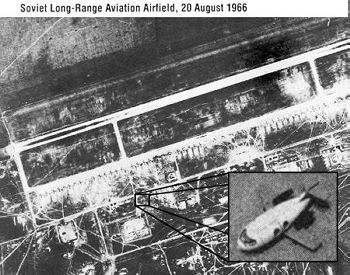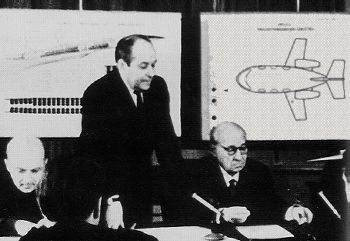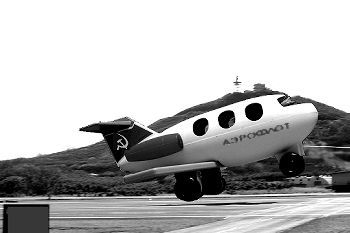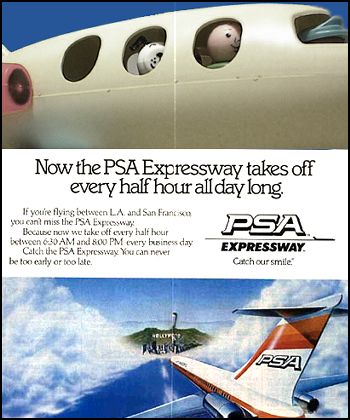 Basic layout of the Fisher-Price aircraft. (Interavia)  American military satellites first detected construction of the prototype at Saratov in 1966.  Alexei and Andrei Tupolev, 1969.  First flight, 1970, Saratov.  The Tupolev Tu-164 began Aeroflot service in 1971.  Pacific Southwest Airlines began using the Fisher-Price design in 1978 for its San Francisco - Los Angeles route.  Fisher-Price FP-72 at Denver, 2001. |
HISTORY OF THE FISHER-PRICE AIRPLANE (Tupolev Tu-164) Almost forgotten, the Fisher-Price Airplane is a relic from the 1970s, a rare example of a Soviet design that was adopted by Western airlines. It is the predecessor of regional jets, which are beginning to form the backbone of major U.S. airlines.  The Soviet requirement In 1951, Stalin had reiterated his call for "one of the toughest engineering problems facing our nation" -- a plane that could carry a dad, a mom, their family, and the dog to a playground in Irkutsk. Tupolev had the courage to tell him that it couldn't be done. The task was simply "impossible to fulfill" owing to the "limits of contemporary knowledge". In his memoirs, Khrushchev emphasized that Tupolev was telling this to a man who had already jailed him for years on a manufactured pretext. But he understood his responsibility. He knew such a plane was impossible, and he told Stalin so. Tupolev was placed under house arrest until Stalin's death in 1953. It wasn't until 1962 when jet engine technology and engineering had made the necessary advances. However, Andrei Tupolev's approach to his aircraft was more pragmatic than some of his early designs would suggest. He emphasized the need for plastics, which would yield tremendous weight savings. Tupolev turned to leading engineers at the Soviet Academy of Sciences. Together they developed an isotactic polypropylene compound, which was adopted for the new project. Construction of the new plane, dubbed Tu-164, began in 1968, and the first flight of the prototype was on May 7, 1970. Khrushchev enjoyed the status of Tu-164 Kurator, formalizing his commitment to bring together the Soviet economy to bear on this high-profile project. Unfortunately, Khrushchev died in September 1971 and the project survived him by only six months. Ironically, Brezhnev's faith in technical progress led to the demise of the Tu-164 program, as resources had to be funnelled to the emerging MiG-23 fighter program. Only two aircraft were built, all in service with Aeroflot. The Fisher-Price years In 1973, Tupolev licensed the design to Fisher-Price, a toy manufacturer in East Aurora, New York. Fisher-Price intended to shelve the design as an investment. However the company was approached by Pan Am, who was seeking a plane to handle its long, thin routes. Fisher-Price had just completed its Cinderella movie camera and a successful record player. Suddenly it found that it needed a line of bank credit totaling $350 million to finance hangar space and tooling. Unfortunately it lacked the assets to pledge as collateral, and its financiers demanded security. Fisher-Price made inquiries about a federal loan guarantee: a pledge that the Treasury would reimburse the banks if Fisher-Price should fold. On September 12, 1974, Fisher-Price met with President Ford. The Administration announced it would send the necessary legislation to Congress. Congressman Wright Patman, chairman of the House Banking Committee, had blocked federal support for the bankrupt Penn Central Railroad just a few years earlier, and was highly skeptical of the new measure. However Congress had killed the SST project in 1971. With an ongoing recession and the threat of additional lost jobs, Congress could not lightly affront the labor unions a second time. Fisher-Price got its financing. Fisher-Price began construction in 1975, naming the model FP-72. The first customer was Braniff Airways. It was a business airline par excellence, offering frequent service in medium-size 727s. Adding the Fisher-Price aircraft meant businesspeople could easily get the connections they wanted. Braniff's chairman and CEO, Harding Lawrence, insisted that the Fisher-Price plane would bring easy connections to Sesame Street, and connect Dallas to all of Texas' barnyards and barbecues. Braniff put in an order for 26 aircraft with 38 on reserve. The first flight of the licensed prototype was in 1976. The aircraft entered service in 1977 with Braniff, followed by Pacific Southwest Airlines, Frontier Airlines, and Aeromexico. Basic dimensions
Reader comments From: Kuzmin Yuri <______@rambler.ru> Date: Fri, 25 Feb 2005 19:37:46 +0300 Hi, Tim! Thank you a lot for your fine esse about Tu-164. A lot of fun. Please, change "Moscow's Academy of Sciences@ on "Soviet Academy of Sciences" (there was never separate Moscow academy in USSR). With best regards, Yuri Kuzmin, Moscow. |